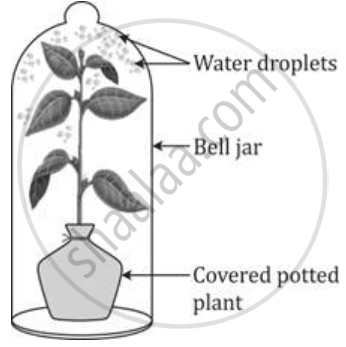Advertisements
Advertisements
प्रश्न
An apparatus as shown below was set up to investigate a physiological process in plants. The setup was kept in sunlight for two hours. Droplets of water were then seen inside the bell jar. Answer the questions that follow:

List three adaptations in plants to reduce the above mentioned process.
उत्तर
Adaptations in plants to reduce transpiration are
- Leaves may be modified into spines as in cactus or into needles as in pines.
- The number of stomata is reduced and they may be sunken in pits.
- Leaves may be folded or rolled up.
APPEARS IN
संबंधित प्रश्न
Water reaches great heights in the trees because of suction pull caused by ______.
State whether the following statement is true or false. Rewrite the false statement correctly.
Transpiration cools the plant when it is hot outside.
Define the three processes by which plants absorb water and minerals from the soil.
Multiple choice question. Tick (✓) the correct choice:
The loss of water through the stomata of leaves is called
(a) transpiration
(b) wilting
(c) evaporation
(d) osmosis
Given alongside is the diagram of an experimental set-up to demonstrate a certain phenomenon in plants.
Name the phenomenon being demonstrated.

Design an experiment to demonstrate the transpiration process.
Plants lose water by the process of transpiration.
What causes the opening and closing of guard cells of stomata during transpiration?
Water molecule is very polar. Polar end of molecule attracts opposite charges on another water molecule (acts like magnet). How will you explain this property of water with reference to upward movement of water? Comment on the upward movement of water given the intermolecular hydrogen bonding in water.
Briefly describe the following:
Angina Pectoris
